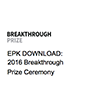Date:
Monday, November 9, 2015

 The Super-Kamiokande Experiment Awarded
the Breakthrough Prize in Fundamental Physics
....................................................................................................................................................................................................................
The Fundamental Physics Breakthrough Prize, presented by the Breakthrough Prize Foundation, was awarded “for the fundamental discovery of neutrino oscillations, revealing a new frontier beyond, and possibly far beyond, the standard model of particle physics”. The prize is valued at 3 million U.S. dollars and is shared among five international experimental collaborations studying neutrino oscillations: Super-Kamiokande (Super-K), KEK-to-Kamioka/Tokai-to-Kamioka (K2K/T2K), Sudbury Neutrino Observatory (SNO), Kamioka Liquid-scintillator Anti-Neutrino Detector (KamLAND), and the Daya Bay Neutrino Experiment (Daya Bay).
The award was presented at a ceremony at the NASA Ames Research Center in California held on Nov. 8. The ceremony was broadcast live in the U.S. on the National Geographic Channel, and was hosted by comedian Seth MacFarlane. A rebroadcast is scheduled for Fox on Nov. 29, at 7 p.m. ET. The Breakthrough Prizes honor advances in Mathematics, Fundamental Physics, and Life Sciences. The prize was established in 2012 by Yuri and Julia Milner, Sergey Brin and Anne Wojcicki, Jack Ma and Cathy Zhang, and Mark Zuckerberg and Priscilla Chan.
The Super-Kamiokande detector is comprised of 50,000 tons of water lined with 13,000 optical sensors, and is located 1,000 meters underground in the Kamioka mine in Japan. The Super-Kamiokande detector is used to study neutrinos from cosmic rays, the sun, supernovae, other astrophysical sources, and search for the decay of the proton. The Super-Kamiokande detector is also an integral part of the K2K and T2K long-baseline neutrino experiments that were also awarded the Breakthrough Prize, when it is used to detect neutrinos from an accelerator beam.
The Super-Kamiokande collaboration announced the discovery of neutrino oscillations in 1998, based on the observation of neutrinos created by cosmic rays, so-called atmospheric neutrinos. They found that atmospheric muon neutrinos traveling great distances through the earth were disappearing, because they were changing into tau neutrinos. In 2001, the Super-Kamiokande collaboration published detailed studies of electron neutrinos produced by nuclear reactions in the sun, which revealed that the transformation of solar neutrinos was dictated by a fundamental parameter of nature.
The discovery of neutrino transformations led to the conclusion that neutrinos have mass and that the Standard Model of particle physics was incomplete. This opened the door for numerous follow-up experiments, including several that shared the Breakthrough Prize, as well as others proposed for the future.
The present members of the Neutrino Group at UCI are Professor Hank Sobel, Adjunct Professor Mark Vagins, researchers William Kropp, Shunichi Mine and Michael Smy, postdoctoral researcher Muhammad Elnimr and graduate students Voldymyr Takhistov and Pierce Weatherly.
The Super-Kamokande experiment was awarded the 2015 Nobel Prize in physics a few weeks ago.
The Super-Kamiokande experiment was built and operated with funding from the Japanese Ministry of Education, Science, Sports and Culture, and the U.S. Department of Energy, Office of Science, and benefits from the cooperation of the Kamioka Mining and Smelting Company.
....................................................................................................................................................................................................................
For more information on the Breakthrough Prize: breakthroughprize.org
Video and images from the ceremony can be downloaded at: www.image.net/BreakthroughPrizeCeremony2016
|
